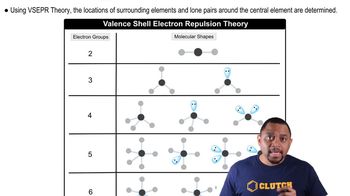Here are the essential concepts you must grasp in order to answer the question correctly.
VSEPR Theory
Valence Shell Electron Pair Repulsion (VSEPR) Theory is a model used to predict the geometry of molecular structures based on the repulsion between electron pairs surrounding a central atom. According to this theory, electron pairs, including bonding and lone pairs, will arrange themselves to minimize repulsion, which directly influences bond angles. In the case of H2O, H2S, and H2Se, the presence of lone pairs and the size of the central atom will affect the bond angles.
Recommended video:
Molecular Shapes and VSEPR
Electronegativity
Electronegativity is a measure of an atom's ability to attract and hold onto electrons within a chemical bond. In the context of H2O, H2S, and H2Se, the electronegativity of the central atom (O, S, Se) influences the distribution of electron density and the size of the electron pair domains. Higher electronegativity leads to stronger attraction of bonding electrons, which can affect the bond angles due to changes in electron pair repulsion.
Recommended video:
Bond Angles and Atomic Size
Bond angles are the angles formed between adjacent bonds in a molecule and are influenced by the size of the central atom. As the central atom increases in size from oxygen to sulfur to selenium, the bond angles tend to decrease due to the larger electron pair domains that result from the increased distance between the nuclei. This trend is important for understanding how the geometry of H2O, H2S, and H2Se varies.
Recommended video:





